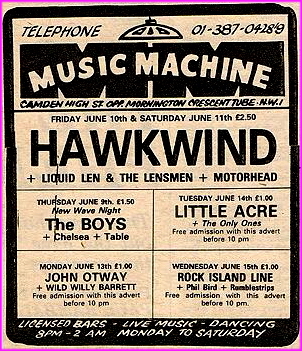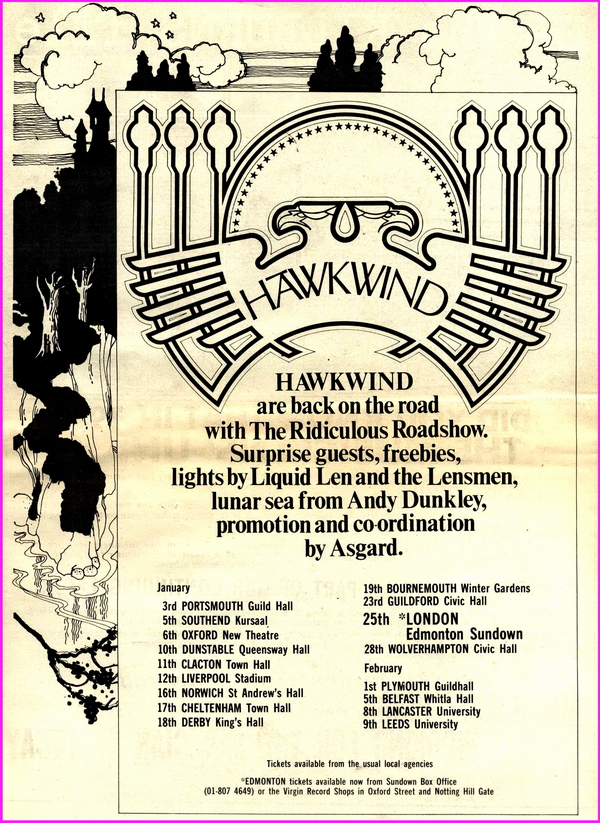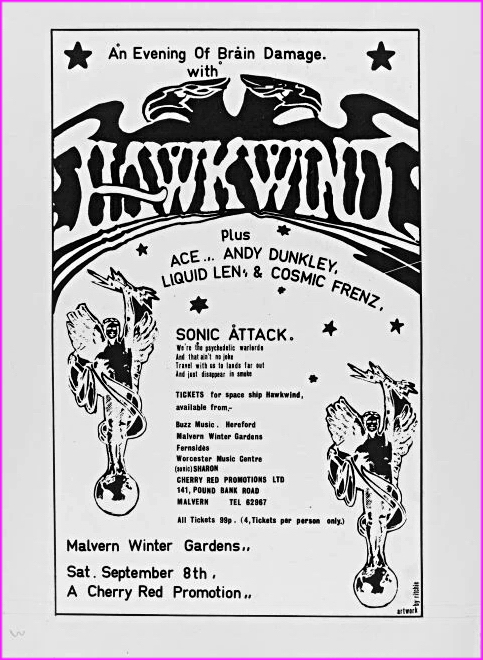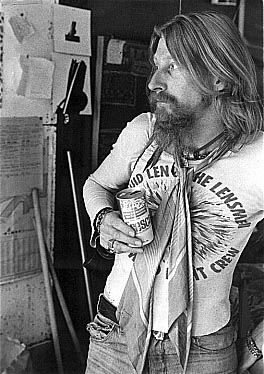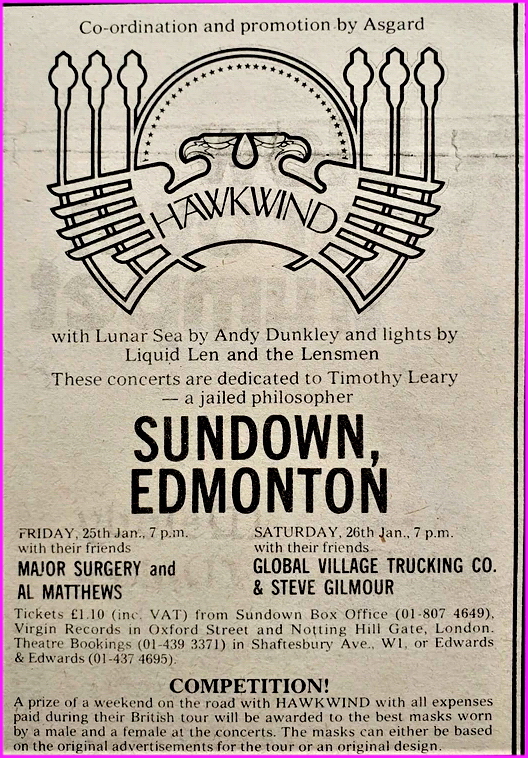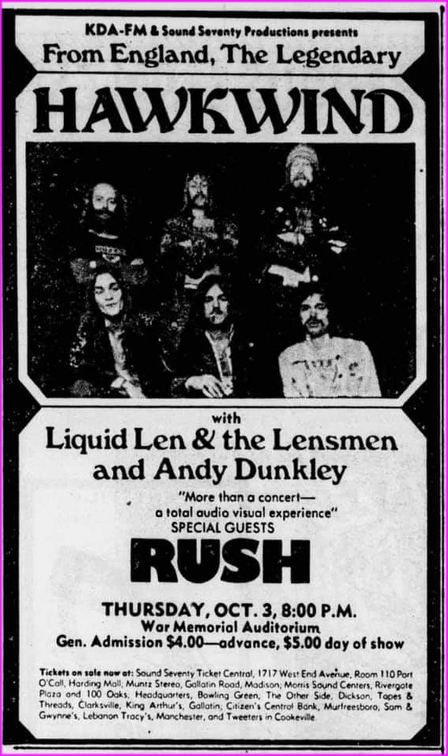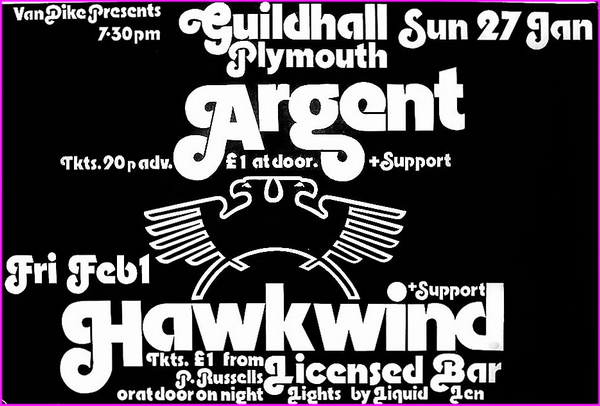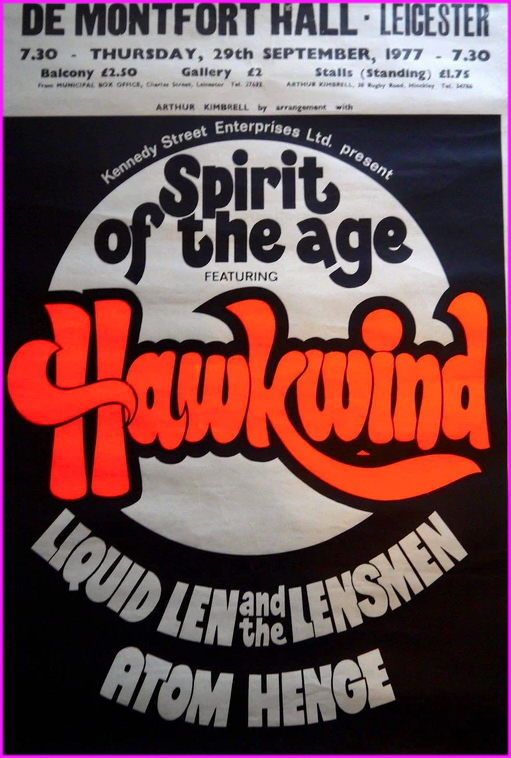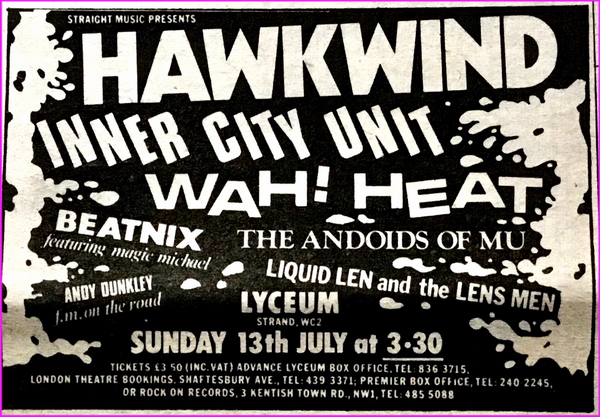Liquid Len & The Lensmen were one of Hawkwind's more famous Light Shows during their early years.
Personnel:
Jonathan Smeeton AKA Liquid Len
Mike Hart AKA Molten Mick
Alan Day AKA Astral Alan
Using mainly slides instead of kinetic wheels on GAF Instamatic Projectors Liquid Len produced massive shows for many Hawkwind gigs but it wasn't always Liquid Len AKA Jonathan Smeeton at the controls - he wrote a 'specification' to which the Hawkwind Light Show should adhere to so textbook shows could take place in his absence..
We have made repeated attempts over the last 20 years to contact Jonathan Smeeton regarding Liquid Len but for reaons best known to himself our requests for information have been ignored - you can draw your own conclusion as to why this might be the case...
We can however bring you this interview (with permission from Jerry Gilbert who has more respect in the Lighting Industry than Pooterland):
Part One:
The Legend of Liquid Len.
On March 8 2009, Hawkwind surrogate, The Hawklords were set to turn back the clock 35 years and play a one-off reunion in honour of the late English graphic artist, Barney Bubbles.
Fittingly, this would be a Space Ritual 2009 show, inspired by Bubbles’ artwork for the original 1973 album and Robert Calvert’s space-rock opera show, with a nod to the artist’s bleak monochromatic concept for the Hawklords’ 25 Years On production later in the decade.
Equally appropriate was the fact that the extravaganza was being promoted by John Curd, whose Head Records label had enshrined the whole spirit of what was taking place around Notting Hill and Ladbroke Grove nearly 40 years ago; which is where this story begins.
According to Wikipedia, “The Space Ritual show [of December 1972] attempted to create a full audio-visual-cerebral experience, representing themes developed by Barney Bubbles and Robert Calvert entwining the fantasy of Starfarers in suspended animation travelling through time and space with the concept of the music of the spheres.” In other words, a lunar safari.
The ringmaster in this travelling circus (or ‘Hawkestra’), which included sci-fi writer Michael Moorcock and the body-painted, curvaceous and entirely naked ‘exotic dancer’ Stacia [Blake], was one of the first real celebrity lightshows, Liquid Len & The Lensmen.
As a music journalist, I attended many Sunday afternoon Roundhouse Implosions (the name coined by Caroline Coon, DJ Jeff Dexter, Ian Knight, Rufus Harris and Huw Price) back in the day, diving into the brutal immersion tank created by Len’s battery of unregulated strobes and 1000W projectors.
For me, that throbbing, pulsating juggernaut in the psychotropic/psychedelic Roundhouse rotunda, mixed with Bubbles’ gothic sci-fi graphics and fascist symbolism, remains indelible.
Whether you were acid-charged or not (and many were), by the time this band of hippy vagabonds had launched into their third number you’d swear you were seeing orbs of light.
Subjected to this relentless blitz the band didn’t seem so much galactic warriors teetering on the edge of the astral plain, as crash test dummies.
It was probably too much to expect that Hawkwind co-founder Nik Turner — in attempting to recreate the zeitgeist 35 years on — would be able to lure the cosmic lightlords back into the fray, despite promoter John Curd billing an appearance by ‘Liquid Len & The Lensmen’ on the posters. But the promoter knew the patina of a reformed Hawks (the Wind or Lord version) would be too irresistible a prospect for many of their old fans.
In fact the legendary LD (real name Jonathan Smeeton, who for many years has been domiciled in the States) had agreed to rent his name for the occasion. Would he be making an avatar-like appearance perhaps? Nik Turner confirmed not. “The Hawklords’ lighting will be tailored to the Liquid Len & The Lensmen blue-print,” he said, “with Jonathan Smeeton’s guidance, collaboration and blessing. Expect the unexpected.”
Suffice it to say that Smeeton had agreed to cede his once famous stage name, “since I haven’t used it since Reading...”. This was a reference to the Reading Festival of 1975 when he formally quit the band, along with Stacia. However, Hawks fans still harboured hope that the great man would be controlling the whole enterprise via robots from his Fortress of Solitude at Leipers Fork, 25 miles outside of Nashville.
RE-DISCOVERING ‘LEN’
The gravitational pull to track down Jonathan Smeeton gathered momentum after I stumbled into Nik ‘Thunder Rider’ Turner, the band’s original sax player, at a Charisma Records reunion in Soho shortly before Christmas.
Three months ago I knew nothing about the Roundhouse event but the seed was still germinating after TPi editor Mark Cunningham, with righteous indignation, asked why Chronicle hadn’t yet devoted a chapter to this scion of light. So instead we’re devoting two.
Then I discovered one of my chums, Paul Gorman had just produced a biography on Barney, who tragically took his own life in 1983, and all the cosmic energy seemed to coalesce.
Smeeton’s early experimental work — with Hawkwind and before — had a major influence in shaping modern lighting design. Harnessing technological innovation to his artistic vision, today his creativity remains in high demand, not only in concert touring, but the worlds of film, architecture and lecturing.
I can’t pretend to have seen Jon Smeeton prior to that Roundhouse experience and have only met him in person once — a chance encounter on the stand of LSD at [probably] the 1992 LDI Show in Dallas.
And as for famous early ’70s lightshow, the only other I can recall was Joe’s Lights, who were resident at London’s Rainbow Theatre, and also became the light artists for the 1972 Bickershaw Festival.
ANCIENT OF DAYS
Jonathan Smeeton’s story begins at the legendary UFO club in 1967, two years before I arrived in London to join Melody Maker and became inducted into London’s W10 (Ladbroke Grove) and W11 (Portobello Road) musical demi-monde.
This was the holy grail of free festivals, featuring ‘People’s Bands’ (think Pink Fairies, Quintessence, Deviants) and influential management like Doug Smith’s Clearwater Productions (Hawkwind’s management) and Blackhill Enterprises’ Peter Jenner and Andrew King (Pink Floyd’s original managers).
I had experienced Dantalian’s Chariot’s spectacular psychedelic launch at the National Jazz & Blues Festival in Windsor, but nothing had quite prepared me for the Hawkwind experience several years later.
The emerging creative spirit at that time was largely incubated in the incendiary womb of the art schools (Farnham, Hornsey, Kingston-upon-Thames, etc) — all hotbeds of social unrest. It was while at art school that Smeeton built his first Light Show, which he would use at UFO and Electric Garden (later Middle Earth), featuring three 1000W projectors.
But these inventions had less to do with any ‘art school movement’ than a simple fiscal imperative. “It was sheer lack of money — it was 1967 and I needed a summer job. I found Middle Earth, a hippy night club about to open in Covent Garden who needed someone to run their lightshow... which meant fixing their projectors, learning how to boil ink and stay up all weekend long.
“Middle Earth is where it started for me. I just walked through the door, asked for a job and, became the lightshow guy... just like that!” In keeping with the idiomatic nomenclature of the day, he called his lightshow The Ultradelic Alchemists.
Apart from all-night weekend stints at the landmark venue, Smeeton also worked Friday all-nighters at UFO. “When UFO moved from the Blarney Club in Tottenham Court Road to the much larger Roundhouse [in Chalk Farm] lightshows were recruited to fill the extra screen space... and there we were.”
He soon supersized his rig. Lighting artillery back in 1967 consisted of “just lots of Aldis projectors — usually, three per screen. Little by little, I acquired more and more projectors to fill more and more screen space.
We all got paid by the projector so the more, the merrier!”
In this brave new world the method of projection used in the UK was to boil ink and transparent glass stain between multiple glass 2” slides using conventional slide projectors. “It wasn’t long before we added footlights, and started to use multiple slide projectors to produce crude five cell animation loops.”
The footlights, photo-floods — three (RGB) per unit — were all controlled individually from a keyboard arrangement, The Colour Organ. “There was no dim, it was just flashing and flickering. Then came slide animation using five GAF Anscomatic 500W slide projectors.
Strobes were also a new effect.” It was during the summer of 1970 that Steve Winwood had persuaded Smeeton to build a show for Traffic, which incorporated for the first time that keyboard control system.
Between residencies at UFO/Middle Earth and joining Hawkwind full time, Smeeton had provided stage lighting for bands on the Notting Hill-based Island Records label like Free, Mott The Hoople and the aforementioned Traffic. “I was using mostly footlights — a hold-over from the lightshow days — and two, three, even four pipe and base towers, mostly for town hall gigs around England.”
Through ’68 and ’69, the LD spent time on the road in Europe by which time the first wave of psychedelic lighting was all but over. He turned his attention to stage lighting, adding Frank Zappa and Captain Beefheart to his roster.
“The first theatrical lighting I used was rented from Strand Electric, before they became Rank Strand — Pattern 23s, 123s and, later, 232s. The Pattern 252 effects projector was also a favourite. I used them well into the ‘80s because they produced particularly good cloud effects. I also used the Strand ‘Tubular Ripple’ effect, which I still, on occasion, use to this day.”
SOCIAL NETWORK
Living in Ladbroke Grove, Smeeton knew Nik Turner, who would often convince him to turn up for their free shows with Andy Dunkley DJ’ing. Turner was at the centre of the social network in W10 and W11 — London’s own little Haight Ashbury.
He spent his time sleeping on the floor of Barney Bubbles, who was artistic director of Frendz magazine, or dossing at the Clearwater offices with future Hawkwinder DikMik, while by day delivering silk screens for the Family Dog shop, who sold hippie/psychedelic accoutrements in Blenheim Street. “I think I then moved in with [Robert] Calvert and we formed a bit of a commune.”
Starting as Hawkwind’s roadie, once Turner had picked up his sax he was immediately drafted into the original line-up, and while Dave Brock was the front-man, he became the glue that held the whole thing together.
Smeeton, meanwhile, was continuing to tour. But after losing his stage equipment in the legendary Montreux Casino fire of December 1971 whilst working with Zappa, he was formally invited by Hawkwind to form the new lightshow prior to the Space Ritual tour.
“I had heard about him and knew he was working a lot for Blackhill Enterprises and doing quite a lot of Island acts,” remembers Turner. He was always busy. He developed a style of multiple projection and had about 20 with a different image in each — like cartoon butterflies and so on.
“Ultimately I approached him about doing lighting for us because we had no regular lighting person and we were getting big for our boots. Up until then I think we used whatever lighting happened to be at the gig.”
As psych bands started to attract audiences way beyond the scope of London clubs it was Smeeton’s ability to provide ground-breaking stadium-sized shows, using mainly slides rather than kinetic wheels, which would attract the attention.
“Around the same time, supergroups arrived and so did the 1000W PAR 64 light along with the first trusses [usually crude antenna truss]. Everybody wanted big, and they paid well too. But I chose the Hawkwind route and the experience has served me well.”
Although Hawkwind manager, Doug Smith’s memory is sketchy, Smeeton’s own recollection of the metamorphosis [into Liquid Len] was that the manager had wanted a name to put on the bill: ‘Lights by......’.
“It’s a play on words, ‘Liquid Lens’ — plus I think I was reading a [space opera] book called ‘The Lensmen’ at the time. Of course I was thinking it had to be ‘Someone & the Somebodys’. A dig at Motown perhaps? Little did I suspect the name would haunt me for the rest of my days!”
So were there actually any ‘Lensmen’? Well yes, of course. The wingmen originally comprised biologist, ‘Molton Mick’ Mike Hart (who later became a veterinary haemotologist), ‘Astral Al’ Alan Day, John Perrin and John Lee. “But later, as Hawkwind became more committed to touring and travelling to the USA more often, the permanent core became myself, John Lee and John Perrin; Mike and Alan both had proper jobs.”
With John Lee contributing his 17cwt van to become Britain‘s first lightshow ‘roadie’, they hauled a 20-projector show around the increasingly large venues, to meet increasing demand after Hawkwind’s ‘Silver Machine’ had gone to No.2 in the singles chart... and the money started to flow.
What a farrago the collective represented. Liquid Len was expected to animate a scenescape comprising an exotic dancer, a poet, sci-fi writer Michael Moorcock, the audio generator work of Dik Mik and graphic sets of Barney Bubbles. Small wonder he added a pinch of nitroglycerine to the mix.
REVOLUTIONARY
The 1972 Space Ritual tour had been a landmark, but by 1974, as they embarked on the second of their three US tours in 12 months, most of the slide material had been replaced and new concepts evolved, with the band threatening to spiral out of control in the face of ever more revolutionary equipment.
From a content perspective there was little of Bubbles’ work. The main providers were Sally Vaughan, who had been responsible for the first sets of animation slides for the Traffic show back in ’70, Nick Milner, plus leading sci-fi artist David Hardy, who contributed a fund of ‘spacescape’ slides.
There was, in fact, very little integration whatsoever among the creatives, Smeeton remembers: “The band were the band, the lightshow was the lightshow; I don’t think we ever projected any of Barney’s art other than the Hawkwind double-headed Hawk logo.
“We both lived in the Ladbroke Grove area in London so we saw a lot of each other. Things were discussed in normal conversation, but we never really sat down and had a production meeting.”
Lord of Light
Part Two:
The conclusion of Jerry Gilbert’s exploration of the life and career of lighting designer Jonathan Smeeton
Although Jonathan Smeeton collaborated little with Hawkwind’s visionary graphic designer Barney Bubbles during the early Space Ritual days, they did work consciously and co-operatively on developing the visuals for the 1978 Hawklords tour, after the LD had briefly returned to the offshoot band several years later.
“Yes, I came back for the Hawklords, which seemed a good idea at the time, but Hawkwind [by then] was at a new level of madness!” recalls Smeeton. “That really was the only time Barney and I ever deliberately sat down and discussed the design. He produced a lot of film footage to be incorporated into the show and we discussed screen placement and structures — and the timing and such.”
It was to be projected on screens suspended in scaffold towers, surrounded by lights. “I finally perfected that scaffold tower design concept for the Thompson Twins in the mid-’80s... minus the film loops,” he remembers.
On tour, Smeeton generally roomed with his old friend, Hawkwind co-founder Nik Turner. “This was probably because we shared fairly quiet lifestyles,” says Turner improbably.
But one incident in Nashville in 1973 was to become a defining paradigm in the Hawkwind hagiography. Turner takes up the story. “We played a concert in this club and the local promoter also managed of a lot of porn houses. Afterwards we were hanging out in the manager’s office when these hillbillies rode in on choppers.
They had this tetra-hydro-cannabinol (THC) — which is the essential component of cannabis — in crystal form. When you snort it, it turns you to rubber — it was outrageous.”
From there they went to a skating rink when suddenly the roof started shaking. “It was like, everyone lie down on the floor, there’s a tornado happening. Comet Kohoutek was also in the cycle and you didn’t know if you were actually experiencing it or whether it was part of the trip. When we got back to the hotel half the roof was gone and all the windows had been blown out of the cars and the water sucked off the swimming pool.”
Once again life seemed to be imitating art, and although it induced a positive vibe, the chemical world seemed to have mutated with the cosmological, Turner describing it like a scene from Polanski’s ‘Repulsion’.
This is a classic Hawkwind anecdote. “It was the same as Jonathan’s lightshows,” says Turner. “You just couldn’t detach it from your own reality.”
Smeeton was forever experimenting with new effects, Turner remembers. “Like the rainbow strobe he developed, using primary colours and sequentially operated to produce rainbow effects — it was fantastic!” His only regret, perhaps, is that Smeeton hadn’t perfected the art of transmuting this, alchemically, into ingestible form.
However, even this may be somewhat surprising when one considers that the occupation given on Smeeton’s passport (according to Hawkwind manager, Doug Smith) was ‘Inventor’.
“In the early days, Jon and I spent a lot of time smoking ganga and had lots of crazy ideas,” says Smith. One of them was called ‘Crowd Control’. “We planned to have lots of little robots like obstacles on the ground; they would be filled with some very heavy weights and patrol the audience — and when people got silly they would start nudging their legs.
“Jonathan was very into drawing and developing things — but there was a humorously wicked side. Dave Brock wanted to see how many people he could freak out — at one point there was a lot of repetitive music in the early shows and we used strobes heavily and watched the number of people being carried out.”
Before Health & Safety restricted the flash rate of strobes to four flashes a second, anyone with photosensitive epilepsy could find that the rapid frequency of stroboscopes triggered a seizure.
Hawkwind were not alone in this regard. Paul Brett from Elmer Gantry’s Velvet Opera remembers their band being plastered all over the national press after colleges and universities banned their use of strobes, following the over-zealousness by their LD Ron Harwood. “Strobe lighting has a dangerous hypnotic effect upon audiences, particularly on girls,” ran the article.
After the royalties from ‘Silver Machine’, gave Hawkwind more money to play with, the lighting was placed more in Smeeton’s hands and presented properly on stage. “We had monkey rigs with PAR 64s and we started building the footlights,” Smith recalls.
Another member of Hawkwind’s band of technical support gypsies and creatives, Gerry Fitzgerald remembers all kinds of ideas that had to be aborted for technical space reasons — a collapsible 32’ eagle for the Space Ritual tour being one that would have seriously interfered with Smeeton’s projection.
Other stillborn ideas were the attempt to pump dry ice downwards as a projection screen — but after a similar attempt at the Farnborough Air Display ended in explosion, it was mothballed.
“There was also the escapade with soap flakes,” says Fitzgerald. “A couple of roadies with a big box of Lux soap flakes were to be dribbled down and picked up by Jonathan’s UV and strobes. But at the Rainbow, there were these two big fans and by the side of the stage the mains switch for the fans. All a roadie needed to do was kick it and accidentally switch it on.”
Sure enough that is precisely what happened — and as the soap flakes were gently drifting down these huge fans kicked in on full power, sending the soap flakes into turbo mode (unwittingly creating the first audience blinders perhaps?) “But no-one seemed to bother,” said Fitzgerald, “they just felt that... well, it was Hawkwind.”
THE MIDDLE STAGES
In August 1975, Hawkwind had headlined on the first night of the Reading Festival, which proved to be their last gig with Jonathan Smeeton. His work with the band would lead him to even greater things although the immediate aftermath was hardly creative.
The music industry was arriving at a fork in the road — disco was spiralling off in one direction, punk in the other, with the spectre of the ‘supergroups’ and prog-rockers hovering over it all. Ironically, I was working in the indie band hotbed of West London in 1976 — a stone’s throw from the old Clearwater offices — but about to launch a disco magazine!
“Punk had a total disregard for everything, and the staple for supergroups was just huge rigs for no other reason than being bigger than the previous rig,” states Smeeton.
By 1982, Gail Colson, manager of former Genesis frontman, Peter Gabriel, had recruited Smeeton, which provided him with a baptism for the new Vari*Lite — launched by Showco the previous year on Genesis’ Abacab tour.
Smeeton used 16 VL1 heads on the Gabriel tour. “It was a very big deal at the time, me being an independent and Vari-Lite being so incredibly secretive about everything. For a short time Vari-Lite had the monopoly on ‘new’.”
Colson had been one of most understatedly powerful women in the music business when I worked at Charisma Records between 1974-76 (at a time when the company also owned ZigZag Magazine).
Although Tony Stratton Smith had started the label she was unquestionably the power behind the throne. By the late 1970s, however, Charisma’s best years were behind them, and Hawkwind’s arrival on to the label in 1976 helped to galvanise it and keep its prog-rock roster alive.
A 10-year collaboration with Gabriel was followed by stints for Smeeton with Paul Simon, Journey and the Thompson Twins. “Without a doubt I enjoyed my Hawkwind reputation for a long time afterwards,” he acknowledges.
With Gabriel at the helm, Genesis had earlier immortalised Jonathan ‘Liquid Len’ Smeeton in their song ‘The Battle Of Epping Forest’ in the lyric ‘His friend, Liquid Len by name, of wine, women and Wandsworth fame’.
One could speculate that Hawkwind’s 1972 ‘Lord Of Light’ might also have been a nod in his direction.
Since then, Smeeton’s creative vision has resulted in some of the most original stage productions in today’s music and TV business — a legacy of the expertise he gained working with video at BBC Television Centre in London.
“Just getting into the BBC was breaking barriers back then,” he says. “‘Top Of The Pops’ was run by a load of old conservatives who had never recovered from the massive and rapid change in ‘pop music’. They still thought Muriel Young was cool and that kids should watch more ‘Blue Peter’!”
His good fortune was that Pete Drummond, a popular BBC radio DJ (who along with John Peel was championing the new counter-culture), lived upstairs from him. The long-time presenter of ‘Radio 1 In Concert’, Drummond had just become the anchor man for the new late-night BBC2 programme ‘Disco 2’.
“Pete got me the gig of projecting lightshows to accompany the record review segment,” Smeeton recalls. “Soon I was lighting the live act segment before the programme became ‘The Old Grey Whistle Test’. Finally, ‘Top Of The Pops’ recruited us to flash their lights, by which time it was truly old hat! But I did learn to light for TV, sufficiently to be ready for the MTV video explosion.”
Smeeton had already enjoyed a particularly busy video-making period in the ’80s with progressive visual artist Peter Gabriel and The Thompson Twins, Wham! and, later, the solo George Michael — which all proved to be heavy MTV fodder. He also produced notable touring lightshows for Yoko Ono, Lou Reed, Miles Davis and eventually Def Leppard, immediately prior to relocating to the States.
This filmic experience became invaluable with the advent of MTV and artists’ needs for both promotional and feature-length concert videos. Thus Smeeton had moved to the L.A. forest of Topanga Canyon, in order to be close to the muse.
“Everybody suddenly was making videos. As most of it was still being shot on 35mm film, Hollywood became a hot spot for shooting short-form video. At this time a lot of commercial film makers got on board and produced some very fine mini movies. There was also quite a lot of money to be made so it attracted some very talented people.”
ARCHITECTURAL
During the ’90s, Smeeton also found himself lighting many architectural interiors and exteriors “where the brief called for lighting to create mood, drama, a sense of the extraordinary.”
His first foray into architectural lighting had been way back in 1984, after being contacted by Rusty Brutsché, chairman and CEO of Vari-Lite in Dallas. “He asked me to light a building to demonstrate the effect of moving lights on walls of glass and stainless steel. Since then I’ve lit quite few buildings, mostly in a novelty fashion, not truly architectural. But music is still my core business — Nashville is a clue!”
This has now been his home for the past 20 years. “When one has spent so much time touring a place or visiting the same place over and over, it’s hard to say precisely when one moved [to the States],” he states enigmatically. “This time around? I have lived here since the late ’80s. I particularly like life in the USA. It’s near my place of work — namely, the rest of the world.”
His route to the deep south had taken him from Topanga Canyon to the beautiful Russian River, in the northern part of California, and finally a rambling ranch in Tennessee. Clearly, Smeeton likes Big Country... which is about as cosmically removed from the imbroglio of Ladbroke Grove as it gets.
Surrounded by so much beauty it’s little surprise that in his modern work regime global itineraries have become a thing of the past. “I don’t go touring anymore; I send robots and machines and clever young people who think it’s fun to live on a bus and be away for months on end.”
In fact he spends as little time as possible working. “Over the summer I teach around 30 people over about four weeks — beginners mostly. And designs can be done in days or weeks. In total I must work 10 weeks a year.”
WORKING IN THE INDUSTRY
In the 1990s, Smeeton was also a regular on the industry trade fair circuit, mostly designing exhibition lightshows for Martin Professional. “At a time when I was looking for an alternative to Vari-Lite I found Martin, or rather they found me.
“They then asked me to design their trade-show stands and lightshows for SIB [Rimini], PLASA and LDI. It was all rather good fun — creating lightshows for the sake of lightshows — but they also produce some pretty fine equipment.”
As production designer to some of the greatest names in music he has always seen explaining complex lighting techniques to lighting directors as part of the job. Thus, the obvious extension to this was to start his own school, offering regular workshops.
At the same time he has also dived headlong into the world of light/video convergence and content lighting to create multimedia, pixel-driven shows. In fact, he is currently working on a multi-media event called In Search of Space (the ghost of Hawkwind still haunting him) — along with a couple of stage play productions.
“The wheel has turned full circle for me,” he muses. “I’ve never had a difficult time getting anything on the screen, the hard part is getting the right thing on the screen at the right time.”
As he completes his fourth decade in the business, Jonathan Smeeton continues to show how in demand he is from the emerging generation, by pulling a contract that should have made him as happy as a clam. When I was in Florida last Christmas, the FM airwaves were dominated by the songs of beautiful 20-year old country singer, Taylor Swift. She has subsequently crossed over into mainstream and mega-stardom, and is currently on tour... with Smeeton as her production designer and director of creativity.
And so the road, it seems, goes on forever. If Liquid Len & The Lensmen had provided the platform for the launch of an outstanding career in lighting invention, what had it been that characterised those early lightshows to make them so special?
“Me,” came the unequivocal answer. “And the totally free rein Hawkwind allowed me; plus, of course, Douglas Smith who really held it all together and believed it could all happen.” |
